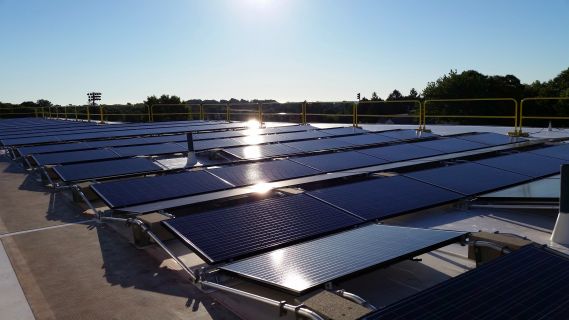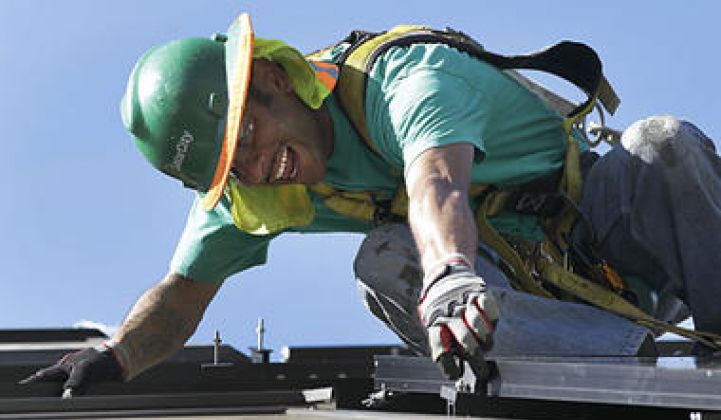Last year, SolarCity, the leading residential distributed energy provider and financier in the U.S., acquired Zep Solar, a solar-module mounting startup, for $158 million in SolarCity stock.
Zep's system makes the solar panel itself part of the racking hardware via a specially grooved frame, eliminating rails and using the module frame as the structural and mounting element. That special frame does not come from Zep -- rather, it comes from a panel vendor that has licensed the Zep design and the aluminum die.
Lyndon Rive, SolarCity CEO, reports that the Zep system "doubled throughput" and brought down the time of install from two or three days to less than one day, adding that it "looked better and made for a better customer experience."
Now SolarCity wants to apply Zep's groove technology to improve installation and increase solar output for commercial rooftops.
Zep Solar's founder Jack West asserts that the lightweight ”snap-together” mounting system will allow businesses to fit 20 percent to 50 percent more panels on each roof and promises to do for commercial solar what Zep has done for residential, while not requiring any roof penetration and using less ballast.
The company claims that "the system’s dense, east-west layout structure will allow SolarCity to fit up to 20 percent more solar panels on standard roofs and up to 50 percent more panels on lightweight roofs, such as those commonly found on warehouses."
The east-west orientation allows more panels on each roof than standard south-facing systems and also captures peak power production over a longer period of the day. SolarCity claims it also allows more efficient sizing and operation of the solar inverter.
As Katie Tweed recently reported for GTM, most homes currently have south-facing panels, but west-facing panels could potentially be more attractive to certain households with high peak loads. West-facing rooftop solar panels produce 49 percent more electricity during peak demand compared to south-facing panels, according to a study from Pecan Street Research Institute. South-facing panels produced a 54 percent peak reduction overall, while west-facing solar PV panels produced a 65 percent peak reduction.
When the data was normalized for a 5.5-kilowatt system, panels turned to the west generated nearly 50 percent more electricity during peak demand hours than did their south-facing counterparts, as we reported.
West notes that the east-west orientation flattens the PV peak and sends more energy to the "shoulders," while allowing inverter size to be reduced because "you don't have to size it for one minute" of peak daily production.
In addition to the panel orientation change and mounting system, Zep also designed its mounting system to address some of the workflow and logistical issues found in real-world commercial rooftop applications. West said the goal is "making the roof like a factory" with a heightened process flow that allows different trades to complete their jobs without waiting for other people to finish first.
Jonathan Bass, a SolarCity spokesperson, calls the Zep system "a game-changer" for residential cost reduction, because with it, a single crew can install twice as many panels in a single day. Bass expects Zep to have a similar impact on commercial installation. The commercial market is different, according to both West and Bass -- and this mounting system has "a broader and more multifaceted impact."
SolarCity's first project with the new commercial hardware is slated for a facility in the city of Quincy, Mass. The company looks to begin installing the new mounting system in volume at the beginning of next year.
MJ Shiao, Director of GTM Research and balance-of-system solar analyst, notes that "the commercial rooftop mounting structure landscape is still very fragmented in the U.S., with no one manufacturer commanding more than 20 percent of the overall market. Although the price environment has made it very challenging for mounting-structure vendors, new innovations targeting more cost-effective solutions are continuing to gain traction. Many of these new technologies and techniques rightfully focus on the speed of installation -- reducing labor costs by targeting the logistics, setup, and assembly of the solution, as well as incrementally reducing the raw material costs."
As for the east-west orientation, Shiao notes, "Of course, theory and practice are always different: potential improvements in power density will depend on site-specific conditions and the resulting cost of energy will have to be competitive, as the system will get less performance for every dollar spent on modules. These factors have to be balanced with the potential benefits."
For commercial systems in non-prevailing-wage labor markets, installation labor accounts for 10 percent to 15 percent of total system costs, and the best way to continue reducing these costs is simplifying the hardware installation process. If Zep can achieve similar results in commercial as it did in the residential space (i.e., halving total system installation times), it will go a long way toward improving commercial solar's competitiveness in the environment of waning incentives and stabilizing solar hardware cost reductions.
Jack West said, "The fundamental idea is to leverage what went into residential and apply it to commercial. At the highest level, the function of Zep was to take the problem and look at it holistically. For commercial roofs, Zep uses the same grooved frame that 'snaps' together and simplifies the installation, eliminating penetrations and reducing ballast. The nature of the mounting system leverages an east-west panel orientation."
West added, "The future of flat-roof installations is in east-west orientation."
New SolarCity mounting hardware for flat commercial rooftops:




